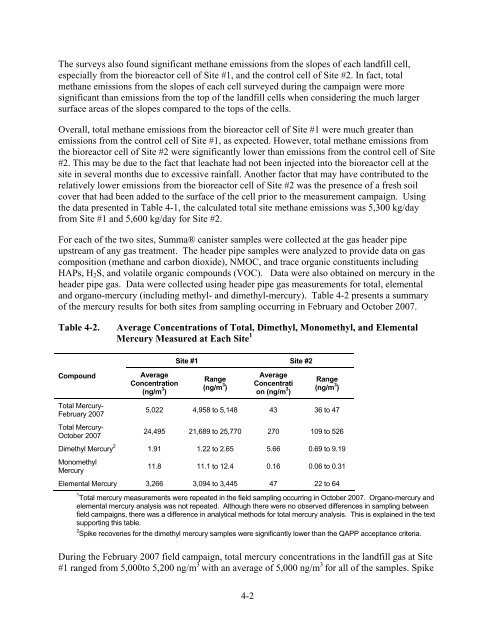Quantifying Uncontrolled Landfill Gas Emissions from Two Florida ...
Quantifying Uncontrolled Landfill Gas Emissions from Two Florida ...
Quantifying Uncontrolled Landfill Gas Emissions from Two Florida ...
Create successful ePaper yourself
Turn your PDF publications into a flip-book with our unique Google optimized e-Paper software.
The surveys also found significant methane emissions <strong>from</strong> the slopes of each landfill cell,<br />
especially <strong>from</strong> the bioreactor cell of Site #1, and the control cell of Site #2. In fact, total<br />
methane emissions <strong>from</strong> the slopes of each cell surveyed during the campaign were more<br />
significant than emissions <strong>from</strong> the top of the landfill cells when considering the much larger<br />
surface areas of the slopes compared to the tops of the cells.<br />
Overall, total methane emissions <strong>from</strong> the bioreactor cell of Site #1 were much greater than<br />
emissions <strong>from</strong> the control cell of Site #1, as expected. However, total methane emissions <strong>from</strong><br />
the bioreactor cell of Site #2 were significantly lower than emissions <strong>from</strong> the control cell of Site<br />
#2. This may be due to the fact that leachate had not been injected into the bioreactor cell at the<br />
site in several months due to excessive rainfall. Another factor that may have contributed to the<br />
relatively lower emissions <strong>from</strong> the bioreactor cell of Site #2 was the presence of a fresh soil<br />
cover that had been added to the surface of the cell prior to the measurement campaign. Using<br />
the data presented in Table 4-1, the calculated total site methane emissions was 5,300 kg/day<br />
<strong>from</strong> Site #1 and 5,600 kg/day for Site #2.<br />
For each of the two sites, Summa® canister samples were collected at the gas header pipe<br />
upstream of any gas treatment. The header pipe samples were analyzed to provide data on gas<br />
composition (methane and carbon dioxide), NMOC, and trace organic constituents including<br />
HAPs, H2S, and volatile organic compounds (VOC). Data were also obtained on mercury in the<br />
header pipe gas. Data were collected using header pipe gas measurements for total, elemental<br />
and organo-mercury (including methyl- and dimethyl-mercury). Table 4-2 presents a summary<br />
of the mercury results for both sites <strong>from</strong> sampling occurring in February and October 2007.<br />
Table 4-2. Average Concentrations of Total, Dimethyl, Monomethyl, and Elemental<br />
Mercury Measured at Each Site 1<br />
Compound<br />
Total Mercury-<br />
February 2007<br />
Total Mercury-<br />
October 2007<br />
Average<br />
Concentration<br />
(ng/m 3 )<br />
Site #1 Site #2<br />
Range<br />
(ng/m 3 )<br />
Average<br />
Concentrati<br />
on (ng/m 3 )<br />
Range<br />
(ng/m 3 )<br />
5,022 4,958 to 5,148 43 36 to 47<br />
24,495 21,689 to 25,770 270 109 to 526<br />
2<br />
Dimethyl Mercury 1.91 1.22 to 2.65 5.66 0.69 to 9.19<br />
Monomethyl<br />
Mercury<br />
11.8 11.1 to 12.4 0.16 0.06 to 0.31<br />
Elemental Mercury 3,266 3,094 to 3,445 47 22 to 64<br />
1 Total mercury measurements were repeated in the field sampling occurring in October 2007. Organo-mercury and<br />
elemental mercury analysis was not repeated. Although there were no observed differences in sampling between<br />
field campaigns, there was a difference in analytical methods for total mercury analysis. This is explained in the text<br />
supporting this table.<br />
2 Spike recoveries for the dimethyl mercury samples were significantly lower than the QAPP acceptance criteria.<br />
During the February 2007 field campaign, total mercury concentrations in the landfill gas at Site<br />
#1 ranged <strong>from</strong> 5,000to 5,200 ng/m 3 with an average of 5,000 ng/m 3 for all of the samples. Spike<br />
4-2















